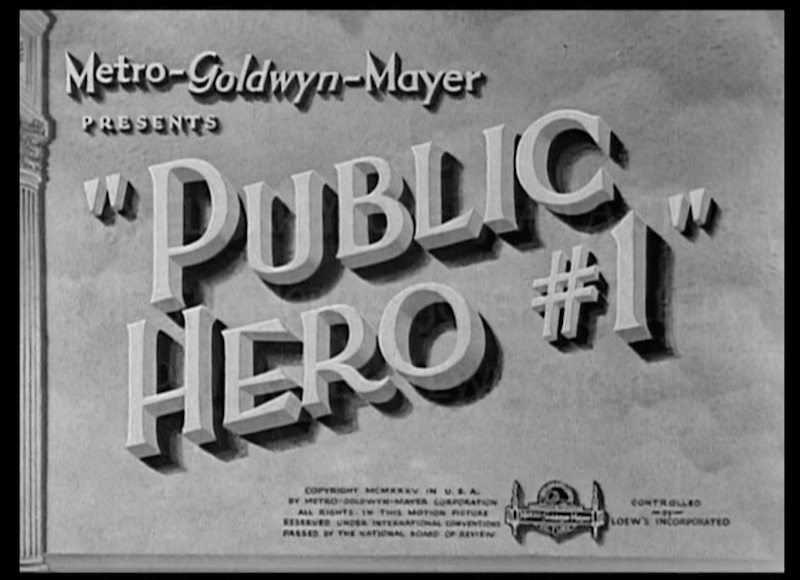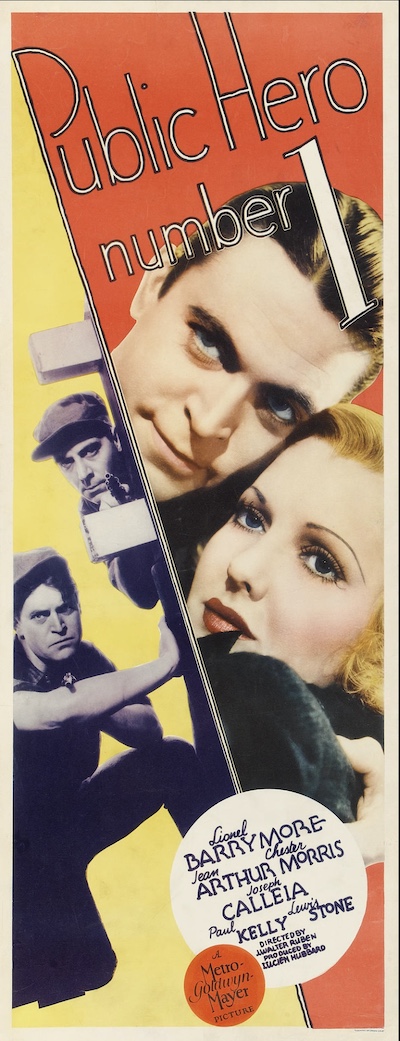Thursday January 25, 2024
Movie Review: Public Hero No. 1 (1935)

WARNING: SPOILERS
So is it “Public Hero Number 1” or abbreviated to “No. 1”? Or hashtagged “#1”? Even MGM couldn't decide. It went hashtag for the title card, abbreviation in the trailer, and completely spelled out for the posters. The confusion continues to this day: Wikipedia goes hashtag, AFI abbreviation, IMDb spells it out. Thanks for the clarification.
I thought the title wordplay was at least original but it turns out not. In the wake of the “Public Enemy No. 1” coinage (circa 1930, for Al Capone), the press, for a time, trotted out its opposite. These are among those touted “Public Hero No. 1” in newspapers in the mid-1930s: Charles Lindbergh, Dizzy Dean, J. Edgar Hoover, and—interestingly—John Dillinger, whose bank-robbing exploits were cheered on in the midst of the Great Depression, and whose story elements are in this thing.
That’s what drew me to the movie in the first place—hearing it was about Dillinger—but it's not. Not really. Yes, we get a shootout in a lodge in rural Wisconsin called “Little Paree,” rather than Dillinger’s “Little Bohemia”; and the main baddie, Sonny Black (Joseph Calleia), is gunned down outside a movie theater the way Dillinger was, but it's in Madison, Wis., rather than Chicago, Ill. That's as close as we get. Black’s gang is actually called “the Purple Gang,” a real 1920s mob that had nothing to do with Dillinger.
We don’t get much Dillinger because you couldn’t even say Dillinger in Hollywood movies in 1935. According to Thomas Doherty in his book Hollywood’s Censor: Joseph I. Breen and the Production Code Administration, the normally wishy-washy Will Hays had “squelched the trigger-happy gangster cycle with a ukase against storylines inspired by John Dillinger.” This was in 1932, two years before the Production Code grew teeth. Why it worked in this instance and almost nowhere else, I don’t know. Why an edict against Dillinger squelched the gangster cycle, I don’t know, either, but squelched it was. After James Cagney’s great turn as Tom Powers in “The Public Enemy,” for example, he was cast more often as grifter than gangster. If he began a movie as a gangster, his arc was toward respectability: reporter in “Picture Snatcher”; movie star in “Lady Killer”; juvenile prison reformer in “The Mayor of Hell.”
Once the code grew teeth in July 1934, all the studios rushed to turn their charismatic gangsters into cops. Warner Bros. actually beat MGM to the punch by a few weeks. “G-Men,” with Cagney, was released May 4, 1935; this one, “Public Hero,” with Chester Morris (a gangster in “Alibi” and “The Big House”), came out May 31.
“G-Men” was better.
Drunk docs and crazy coincidences
 Morris plays Jeff Crane, a new, loudmouth convict in prison, who is stuck in a cell with Sonny, the suspected leader of the “Purple Gang,” who quickly puts him in his place. But Crane learns no lesson and before long gets 21 days in solitary. Afterward, still learning no lesson, he’s got a scheme about breaking out, and does, and brings Sonny along. Except Sonny gets shot and a doctor is needed. Luckily, Sonny has one: Dr. Josiah Glass (Lionel Barrymore). Unluckily, he’s a drunk. Since this is the 1930s, it’s played for laughs.
Morris plays Jeff Crane, a new, loudmouth convict in prison, who is stuck in a cell with Sonny, the suspected leader of the “Purple Gang,” who quickly puts him in his place. But Crane learns no lesson and before long gets 21 days in solitary. Afterward, still learning no lesson, he’s got a scheme about breaking out, and does, and brings Sonny along. Except Sonny gets shot and a doctor is needed. Luckily, Sonny has one: Dr. Josiah Glass (Lionel Barrymore). Unluckily, he’s a drunk. Since this is the 1930s, it’s played for laughs.
On the way to deliver the drunk doc, Crane nearly runs into a bus that skids off the side of the road. On board? A crazily persistent woman named Maria Theresa “Terry” O’Reilly (Jean Arthur), who insists Crane take the stranded passengers back to town. He does, griping all the way. Then she insists he take her to the next town. He doesn’t. But a bridge is washed out, there’s delays, she stows away in his car, etc. That’s how they stay together.
So what’s her deal anyway? She’s trying to hook up with her brother, Dinkie, about an inheritance. And who’s this Dinkie when he’s at home? Yes, it’s Sonny Black. What a crazy coincidence—running into Sonny’s sister when he’s taking a drunk doc to remove a bullet from Sonny. She doesn’t know her brother is a gangster, either. She’s innocent. She’s Jean Arthur.
But she does think that Crane is a gangster, even though, by and by, we realize he’s an undercover fed who is out to get Sonny and bring down the Purple Gang. That’s why he acted so over-the-top in prison. Because he was acting.
Much of the rest of the movie is Crane trying not to fall in love with Terry before he betrays her brother. But when bro slaps her, Crane decks him. For that, Crane loses two gigs. He’s tossed out of the Purple Gang, and then, because his punch wasted months of undercover work, he’s also tossed out of the Bureau, too. Ah, but then he tricks Dr. Glass into taking him to Little Paree, notifies his stickler boss, Special Agent James Duff (one-time real-life convict Paul Kelly), where Little Paree is, and the feds descend. There’s a shootout, Doc gets it, but before dying he reveals that, yes, Sonny is their leader. A few months later, Sonny gets his outside the movie theater where Terry works. Crane pulls the trigger.
Now he just has to win Terry back, and does, kinda, on a train in the last two minutes of the film. It’s not good. You feel for her need to get away. It’s a little creepy.
Sour-pussed sticklers
All of which points out the difficulty of Hollywood shifting gears and ignoring its charismatic anti-heroes for tight-assed, puritanical law enforcement. MGM is trying to make the feds look good here, right? So why do they come off so poorly? They drop Crane at the drop of a hat then welcome him back when he solves everything? Not cool.
Some part of me wonders if the studios weren’t trying hard enough on purpose. I.e., they saw law enforcement as an extension of the puritanical Joe Breen and the Production Code Administration and portrayed them as they were: sour-pussed sticklers, gumming up the works.
Barrymore gets top billing here despite barely being in it, while Arthur is second-billed though you don’t see her for a half hour. That felt odd: watching a movie and not seeing either of the top two stars for 30 minutes. Morris is fine but he’s no Cagney. He’s not even the Morris of “The Big House.” I liked the Morris of “The Big House.”
As for Sonny Black? It took me a while to realize why the actor’s name, Joseph Calleia, was so familiar. Twenty-three years later, he played Sgt. Pete Menzies, the man you could argue (as I did) is the true hero of Orson Welles’ great noir, “Touch of Evil.” Make sure you see the director’s cut.
Baseball's Active Leaders, 2023
What Trump Said When About COVID
Recent Reviews
Everything Everywhere All at Once (2022)
Black Panther: Wakanda Forever (2022)
Doctor Strange in the Multiverse of Madness (2022)
Spider-Man: No Way Home (2021)
The Cagneys
A Midsummer Night's Dream (1935)
Something to Sing About (1937)
Angels with Dirty Faces (1938)
A Lion Is In the Streets (1953)
Man of a Thousand Faces (1957)
Never Steal Anything Small (1959)
Shake Hands With the Devil (1959)







